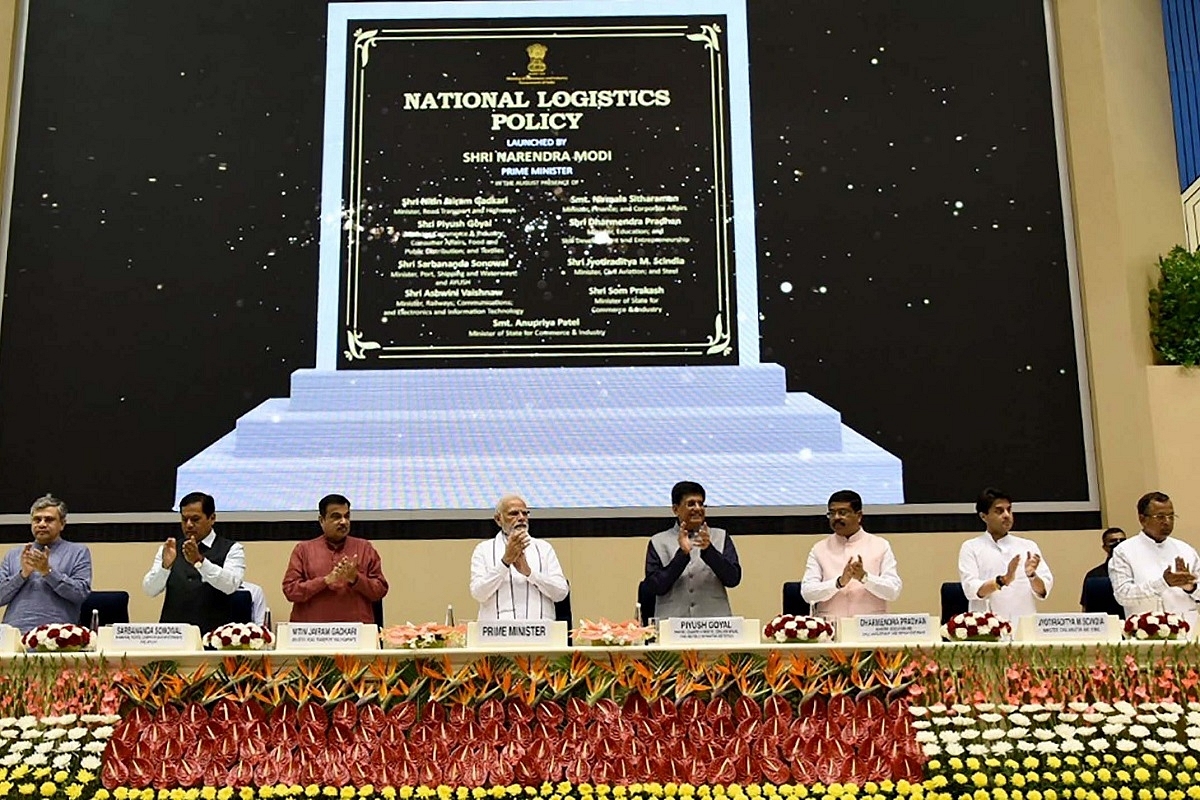Infrastructure
National Logistics Policy — A Programme Whose Time Has Well Come
- While Gati Shakti will be a game-changer for India’s infrastructure landscape, the impetus on logistics got a fillip through the launch of the National Logistics Policy by the Prime Minister.

Prime Minister Narendra Modi at the launch of National Logistics Policy.
Napoleon Bonaparte had famously said, “The amateurs discuss tactics: the professionals discuss logistics.”
If this was primarily alluding to warfare, the modern-day equivalence of it can be found in how nations progress.
Post the economic collapse, including the ‘Great Contraction’ in US from 1929 to 1933, president Franklin D Roosevelt upon assuming office in 1933 introduced the ‘New Deal’.
Among a slew of reforms that it entailed, one was setting up the Public Works Administration (PWA), which included a holistic infrastructure upgrade covering roads, bridges, dams, airports, hospitals, etc, all touching upon logistics.
The result was restoring public confidence and creating new programmes that addressed unemployment.
India has been undergoing a major logistics transformation.
On the eve of Independence Day 2021, Prime Minister Narendra Modi had announced from the ramparts of Red Fort an ambitious Gati Shakti master plan, with an outlay of Rs 100 lakh crore, that would bring 16 infrastructure-related ministries on a common digital platform.
While Gati Shakti will be a game-changer for India’s infrastructure landscape, the impetus on logistics got a fillip through launch of the National Logistics Policy (NLP) by the Prime Minister on 17 September 2022.
Logistics cost in India is around 13-14 per cent of our gross domestic product (GDP) in comparison to about 8 per cent in the developed world.
The Indian logistics sector is estimated at over $200 billion, and the sector provides livelihood to more than 22 million people.
Naturally, the need to cut down inefficiencies and costs within the logistics space has been felt by government since few years now.
The roots of NLP were first laid in 2020 during Finance Minister Nirmala Sitharaman’s budget speech.
The core of this will be to have an integrated and tech-enabled approach to logistics sector, with an aim to bridge efficiency gap.
The key tenets of NLP will be a unified logistics interface platform, standardisation of physical assets and benchmarking service quality standards, state engagement, human resource development, capacity building, export-import logistics, sectoral plans, and facilitation of the development of logistics parks.
Streamlining of processes within the logistics sector is paramount in India, primarily because the sector is inherently complex in its structure.
More than 20 government agencies, 40 PGAs (partner government agencies), 37 export promotion councils, 500 certifications, over 10,000 commodities, 200 shipping agencies, 36 logistics services, 129 inland container depots (ICDs), 168 container freight stations (CFSs), and 50 IT ecosystems — are some of the entities that cater to this vast logistics network in India.
Simplification of this system is clearly the ask of the day.
Four key imperatives stand out within NLP. They are as below:
Integration of digital system (IDS): Gleaning data from seven different departments (road transport, railway, customs, etc), 30 disparate systems will be integrated under IDS.
Lead times for cargo movement will expectedly go down, with concomitant benefits to working capital and cost.
Unified logistics interface platform (ULIP): Smooth and frictionless cargo movement will be monitored via ULIP.
Ease of logistics (E-LOG): Simplification of myriad rules will aid in faster turnaround times.
System improvement group (SIG): This will monitor all logistics projects and flag off any challenge as envisaged at any point in time.
Aside of above, the NLP is also expected to bring in added benefits like single-window approvals, aiding of cargo movement through Indian Railways via additional infrastructure investments, and enhance overall operational efficiency.
The second-order impact of such infra and logistics improvements would be a ‘multiplier effect’, which is typically 2.5-3.5x.
What this means is, for every rupee spent by the government in creating infrastructure, GDP would gain worth Rs 2.5-3.5.
Presently, around 64 per cent of freight in India is moved through roads.
As diesel is the prime driver of road transport, any spike in oil prices would raise overall landed cost of items.
A higher share of railway in modal transport is desirable hence, also because it is a more efficient method. NLP will be a key enabler to this.
NLP will strengthen local manufacturers across sectors, let freight and passengers move swiftly from one place to another, and become a push factor for our exports.
If implemented right, it will be the much-needed booster for our nation’s infrastructure dreams.
When President Roosevelt had introduced the ‘New Deal’ for US, he had proclaimed:
“Throughout the nation men and women, forgotten in the political philosophy of the Government, look to us here for guidance and for more equitable opportunity to share in the distribution of national wealth... I pledge myself to a new deal for the American people. This is more than a political campaign. It is a call to arms.”
Indeed — our National Logistics Policy may just be that — a revolutionary cornerstone to India’s infrastructure turnaround.
The cheetahs have roared, and India is confident to bask in their agility for the next decades to come.
Introducing ElectionsHQ + 50 Ground Reports Project
The 2024 elections might seem easy to guess, but there are some important questions that shouldn't be missed.
Do freebies still sway voters? Do people prioritise infrastructure when voting? How will Punjab vote?
The answers to these questions provide great insights into where we, as a country, are headed in the years to come.
Swarajya is starting a project with an aim to do 50 solid ground stories and a smart commentary service on WhatsApp, a one-of-a-kind. We'd love your support during this election season.
Click below to contribute.
Latest